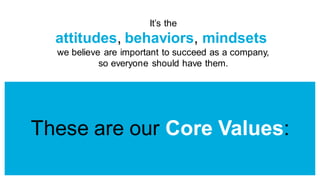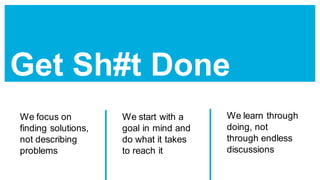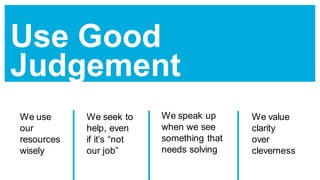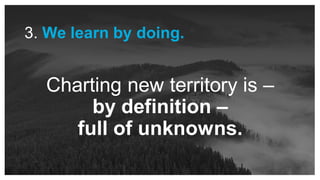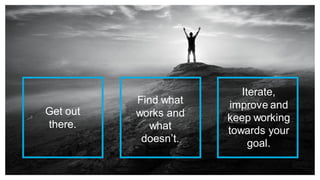Skeleton Culture Code
- 1. Culture Code How our culture helps to save energy.
- 2. Noun 1. Organizational culture is the behavior of humans within an organization, and the meaning that people attach to those behaviors. What is culture? culture | ‘kelCHer | 2. Culture includes the organization’s why, values, norms, systems, symbols, language, assumptions, beliefs, and habits.
- 3. Let’s talk about Skeleton’s culture. On their way to greatness, every company develops a culture that helps them on that journey.
- 5. - Peter Drucker Culture eats strategy for breakfast. Culture is important, but how does it translate into actions?
- 6. It’s the attitudes, behaviors, mindsets we believe are important to succeed as a company, so everyone should have them. These are our Core Values:
- 7. Get Sh#t Done We focus on finding solutions, not describing problems We start with a goal in mind and do what it takes to reach it We learn through doing, not through endless discussions
- 8. Push Boundaries We go outside our comfort zones We act with a sense of urgency We question the status quo We keep trying when others would have given up
- 9. Use Good Judgement We use our resources wisely We seek to help, even if it’s “not our job” We speak up when we see something that needs solving We value clarity over cleverness
- 10. - Lily Tomlin I always wondered why somebody doesn’t do some- thing about that. Then I realized I was somebody.
- 12. Netflix said it best when they said: We’re a team, not a family. We hire, develop and cut smartly so we have stars in every position.
- 13. Having said that, WE LOOK FOR ATTITUDE WITH APTITUDE. Having the right skills is not enough – you also need the enthusiasm and drive.
- 14. However, if you come to work with a spark in your eye, there’s nothing worse than a rude, whining peacock.
- 15. So, like a nightclub, we have a strict door policy: NO PEACOCKS NO WHINERS NO JERKS
- 17. When managing yourself and others, follow these four principles 1. Results 2. WDWBW 3. Iterate 4. Use second order thinking
- 18. 1. We work for results and we realize that the best results are not always achieved at the office between 9 and 5. Sometimes you need peace and quiet to get sh#t done.
- 19. Although keep in mind that we operate as a team, which means meetings and direct communication are required for the team’s results, too.
- 20. Action items without clear responsibilities and deadlines is just talk. 2. WDWBW
- 21. WDWBW Five words that take you from “talk” to “done”. WHO DOES WHAT BY WHEN
- 22. Charting new territory is – by definition – full of unknowns. 3. We learn by doing.
- 23. But don’t get stuck in planning, from the comfort of your desk. So know where you want to go. What is the “big picture” goal?
- 24. Get out there. Find what works and what doesn’t. Iterate, improve and keep working towards your goal.
- 25. The immediate effects of our actions are usually relatively predictable. 4. “And then what?”
- 26. But what we should be asking ourselves is “and then what?”. What comes after the immediate and what after that etc.
- 27. This called second order thinking and it’s the key to success.






